Portal:Heraldry
Welcome to the Heraldry and Vexillology Portal!


Heraldry encompasses all of the duties of a herald, including the science and art of designing, displaying, describing and recording coats of arms and badges, as well as the formal ceremonies and laws that regulate the use and inheritance of arms. The origins of heraldry lie in the medieval need to distinguish participants in battles or jousts, whose faces were hidden by steel helmets.
Vexillology (from the Latin vexillum, a flag or banner) is the scholarly study of flags, including the creation and development of a body of knowledge about flags of all types, their forms and functions, and of scientific theories and principles based on that knowledge. Flags were originally used to assist military coordination on the battlefield, and have evolved into a general tool for signalling and identification, particularly identification of countries.
Selected coat of arms
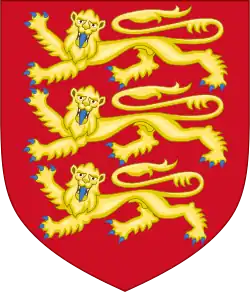
In heraldry, the Royal Arms of England is a coat of arms symbolising England and its monarchs. Its blazon (technical description) is Gules three lions passant guardant in pale Or armed and langued Azure, meaning three identical gold lions with blue tongues and claws, walking and facing the observer, arranged in a column on a red background. This coat, designed in the High Middle Ages, has been variously combined with those of France, Scotland, Ireland, Nassau and Hanover, according to dynastic and other political changes affecting England, but has not itself been altered since the reign of Richard I. (more...)
Selected article
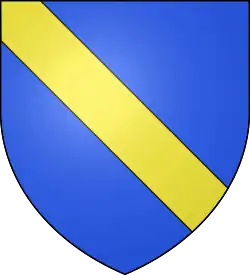
Scrope v. Grosvenor was one of the earliest heraldic law cases brought in England. The case resulted from the fact that two different families were using the same undifferenced coat of arms. In the 12th and 13th centuries, the composition of coats of arms was very simple. Most shields consisted of only one charge and two tinctures, and there were times when two families bore the same coat of arms in the same jurisdiction. In the fourteenth century, though, cases of two unrelated families bearing the same coat of arms became less tolerated. When this happened, the monarch was usually called on to make a decision. (more...)
Selected flag
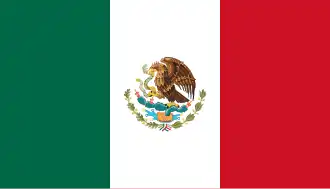
In Article 18 of the Law on the National Arms, Flag, and Anthem (Ley Sobre El Escudo, la Bandera y el Himno Nacionales) there is a listing of dates that the Mexican flag is flown by all branches of government. Civilians are also encouraged to display the national flag on these days. Many of the dates listed in the law denote significant events and people that shaped of Mexican identity and the course of its History. Some of the holidays and commemorations listed require the flag to be flown at half-staff. The national flag can be flown any day of the year by civilians or at festive occasions in persurrence to Article 15 of the Law on the National Arms, Flag, and Anthem. (more...)
Selected picture
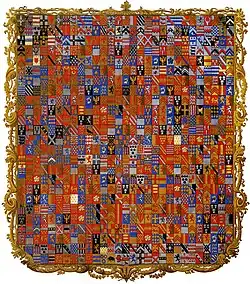
The Grenville Diptych was produced between 1822 and 1839 for Richard Temple-Grenville, Marquess of Chandos the son of the first Duke of Buckingham and Chandos. It shows 719 quarterings of the family, including ten variations of the English Royal arms. The left panel of the diptych lists the quarterings.
Did you know...
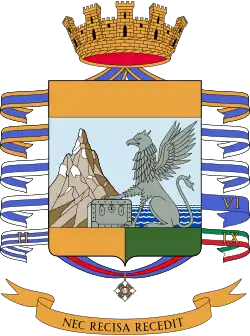
- ...that the Italian mountain Cimon della Pala appears on the coat of arms of the Guardia di Finanza (pictured)?
- ...that C. S. Schilbred was among the founders of both the Norwegian Genealogical Society and the Norwegian Heraldry Society?
- ...that the coat of arms of Ullensaker is the only Norwegian municipal coat of arms depicting a Norse god?
- ...that the symbolism of seated monarch on the Flag of Mide is derived from iconography rather than classical heraldry?
- ...that in 2006 Devon County Council first raised the flag of Devon, which was designed by a member of the public in 2002 via an online poll on BBC Devon?
Related portals
Major topics and navigation
|
Heraldry Heraldry by country Heraldic artists Heraldists Officers of arms Heraldic authorities Heraldic badges Coats of arms Ecclesiastical heraldry Heraldic elements External devices in achievements Flags by design Headgear in heraldry Heraldry and law Literature on heraldry Military heraldry Offices of arms Orders, decorations, and medals Rolls of arms Seals (insignia) Heraldic sites Heraldic societies Heraldic tinctures Totem poles Vexillology Heraldry stubs Vexillology Flag days Flag flying days Flagpoles Flags History of flags Literature on vexillology Vexillological organizations Vexillologists |
Flags Flags by century of introduction Flags by subject Lists and galleries of flags Flags by continent Flags by country Flags by design Flags by year of introduction Types of flags Flag anthems Flag controversies Flag designers Flags adopted through competition Historical flags History of flags Flag manufacturers Flag practices Proposed flags Representations of flags Vexillography Flag images Flag stubs
|
Heraldry Web resources
Authorities
- Belgium - The Council of Nobility, Flemish Heraldic Council and Council of Heraldry and Vexillology of the French Community
- Canada - Canadian Heraldic Authority and see also Public Register of Arms, Flags and Badges
- England, Wales, and Northern Ireland - The College of Arms
- Ireland - The Office of the Chief Herald of Ireland
- Netherlands - High Council of Nobility
- Portugal - Instituto da Nobreza Portuguesa
- Scotland - The Court of the Lord Lyon
- South Africa - South African Bureau of Heraldry
- Sweden - National Board of Heraldry, The National Archive
- United States Army - The United States Army Institute of Heraldry
Societies
- Greek Heraldry Society
- The Academy of Heraldic Science Czech republic
- The American College of Heraldry
- The American Heraldry Society
- The Augustan Society
- The Australian Heraldry Society Inc.
- Bulgarian Heraldry and Vexillology Society
- The Center for Research of Orthodox Monarchism
- Cambridge University Heraldic and Genealogical Society
- Chiltern Heraldry Group
- The College of Dracology
- Croatian Heraldic and Vexillologic Association
- The Finnish Heraldic Society
- Fryske Rie foar Heraldyk
- Hellenic Armigers Society
- Guild of Heraldic Artists
- Genealogical Society of Ireland
- Heraldry Research Institute (Japan)
- The Heraldry Society
- The Heraldry Society of Africa
- The Heraldry Society of New Zealand Inc.
- The Heraldry Society of Scotland
- The Heraldry Society of Southern Africa
- The Institute of Heraldic and Genealogical Studies
- The International Association of Amateur Heralds
- Italian Center of Vexillological Studies
- Lancashire Heraldry Group
- Macedonian Heraldry Society
- New England Historic Genealogical Society Committee on Heraldry
- Norwegian Heraldry Society
- Oxford University Heraldry Society
- Polish Heraldry Society
- Polish Nobility Confederation
- Real Academia Matritense de Heráldica y Genealogía - Royal Academy of Heraldry and Genealogy of Madrid
- Romanian Institute for Genealogy and Heraldry
- The Royal Heraldry Society of Canada
- The Russian College of HeraldryThe Russian College of Heraldry
- Serbian Heraldic Society
- Societas Heraldica Scandinavica
- Societas Heraldica Slovenica
- Swedish Heraldic Society
- Ukrainian Heraldry Society
- Royal Association Genealogical and Heraldic Office of Belgium
- [1] The Yorkshire Heraldry Society
Vexillology
Software
- Coat of Arms Visual Designer web-based program
- Puncher Heraldry Program
- Blazonry Server - pyBlazon
- DrawShield - creates SVG shield or arms image from blazon
- CoaMaker - web-based tool
- Blazon95 and BLAZONS! 2000, older Windows applications
- Heraldicon
Texts
- Heraldry, historical and popular : with seven hundred illustrations (1863)
- A Complete Guide to Heraldry (1909)
Other
Wikimedia
The following Wikimedia Foundation sister projects provide more on this subject:
-
Commons
Free media repository -
Wikibooks
Free textbooks and manuals -
Wikidata
Free knowledge base -
Wikinews
Free-content news -
Wikiquote
Collection of quotations -
Wikisource
Free-content library -
Wikispecies
Directory of species -
Wikiversity
Free learning tools -
Wikivoyage
Free travel guide -
Wiktionary
Dictionary and thesaurus










